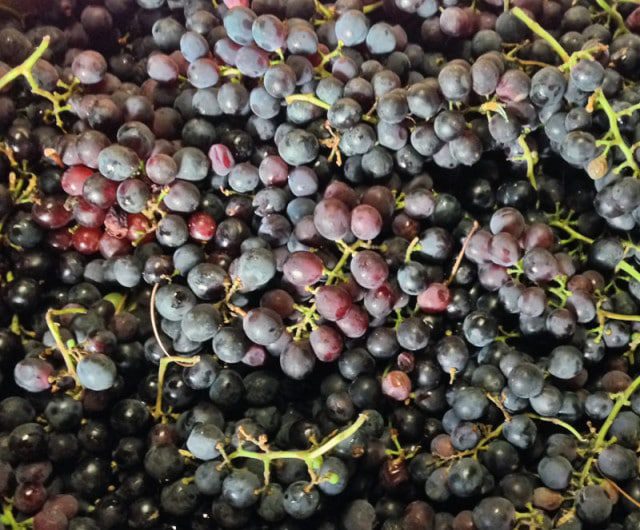A few weeks ago in Cape Town, I posted a recipe for my Flourless Almond Butter Bread – which contains no sugar, oil, or gluten, and is full of wholesome, healthy ingredients. I experimented with this recipe by turning it into muffins and adding just a little bit of sugar to make it more of a dessert. I used brown cane sugar, but you could add a bit of honey or maple syrup or whatever sweetener you prefer. It doesn’t need much, just a couple of tablespoons.
These muffins are super nutritious, low in carbs, and packed with protein and healthy fats. I didn’t have any almond butter at the farm, so I used organic peanut butter – they turned out great!

It’s katoba (aka: catawba) grape season here in the Free State. These are beautiful, deep purple grapes that are very similar (if not the same) to concord grapes in Canada. During this season, the grapes are steamed to extract the juice which is then turned into a concentrate and bottled to enjoy for months to come. We mix it with a bit of water and ice and I’ve been drinking it practically every day! So good. They also make jam with it, and we decided to try the jam with the muffins, along with some homemade Greek yogurt I made with raw, organic Jersey milk. This was truly a delicious treat. Happy Wednesday!

Flourless Nut Butter Banana Muffins
1 cup almond butter or peanut butter
1/2 cup tahini
3 ripe medium sized bananas
4 large free-range eggs
2 tsp cacao or cocoa powder
2 tsp baking powder
1 tsp cinnamon
1 Tbsp apple cider vinegar
2 Tbsp sugar/sweetener of your choice
handful of raw almonds, chopped
Preheat oven to 150C. Mash together bananas, almond butter, tahini, eggs, cacao, baking powder, cinnamon, apple cider vinegar, and sugar. Mix well until smooth. Pour batter into prepared muffin tins and sprinkle the top with chopped almonds. Bake for 50-55 minutes until a toothpick comes out clean. Allow to cool, remove from pan and slice. Enjoy with jam and cream (or thick homemade yogurt). Or some homemade Jersey butter
A note on gluten and your health:
Gluten is a protein molecule found in many grains such as wheat, rye, barley, semolina, spelt and kamut. It’s what makes dough sticky and makes bread elastic and rise. Many people have developed severe allergies and sensitivities to gluten, without even knowing it, which can wreck havoc on the digestive system. Here’s why:
“So, what happens in your gut when you eat gluten?
Whether you are eating a sugary fried doughnut or organic 12-grain bread, the effects of gluten on your gut are the same. When your meal reaches your intestines, tissue transglutaminase (tTG), an enzyme produced in your intestinal wall, breaks down the gluten into its protein building blocks, gliadin and glutenin.
As these proteins make their way through your digestive system, your immune system in your gut, the gut-associated lymphoid tissue (GALT), reviews them for potentially harmful substances. In people who have no issues with gluten, the proteins are absorbed. In those with gluten sensitivity, the GALT identifies gliadin as a dangerous substance and produces antibodies to attack it. In celiacs, these antibodies don’t just attack the gliadin, they attack the tTG as well, which is what originally broke down the gluten into its two parts.
This enzyme, tTG, has a number of jobs, including holding together the microvilli in our gut. Your body collects nutrients by absorbing them through the walls of your intestines, and the more surface area there is, the more they can absorb. Imagine trying to soak up a gallon of water with a paper towel versus a bath towel. Microvilli, which look like hairy fingers, exist in your intestines to increase the surface area and absorb nutrients.
When the antibodies your body produced to defend itself against gliadin attack your tTG, these microvilli can atrophy and erode, decreasing your ability to absorb nutrients and allowing the walls of your intestines to become leaky. This can manifest itself in digestive symptoms, including bloating, constipation, diarrhea, weight loss, fat malabsorption and malnutrition, such as iron deficiency or anemia, low vitamin D or even osteoporosis.This blunting of the microvilli is the hallmark of celiac disease, an autoimmune disease.”
– Amy Meyers, M.D.
When gluten is removed from the diet, studies have found reversals of depression, joint pain, psoriasis, irritable bowel syndrome (IBS), inflammatory bowel disease (IBD) and autoimmune disorders, including Hashimoto’s, arthritis and Type 1 diabetes.
Some good alternatives to gluten-containing grains: rice, oats, buckwheat, millet, amaranth, sorghum, quinoa.













